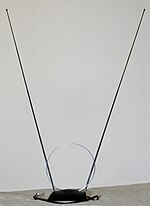
- (left) A television broadcasting antenna in Muehlacker, Germany
- (right) One of the first television broadcasting antennas, on the Empire State Building in New York City for NBC's experimental 46.5 MHz TV station W2XBS in 1939.
Terrestrial television, or over-the-air television (OTA) is a type of television broadcasting in which the content is transmitted via radio waves from the terrestrial (Earth-based) transmitter of a TV station to a TV receiver having an antenna. The term terrestrial is more common in Europe and Latin America, while in Canada and the United States it is called over-the-air or simply broadcast. This type of TV broadcast is distinguished from newer technologies, such as satellite television (direct broadcast satellite or DBS television), in which the signal is transmitted to the receiver from an overhead satellite; cable television, in which the signal is carried to the receiver through a cable; and Internet Protocol television, in which the signal is received over an Internet stream or on a network utilizing the Internet Protocol. Terrestrial television stations broadcast on television channels with frequencies between about 52 and 600 MHz in the VHF and UHF bands. Since radio waves in these bands travel by line of sight, reception is generally limited by the visual horizon to distances of 64–97 kilometres (40–60 miles), although under better conditions and with tropospheric ducting, signals can sometimes be received hundreds of kilometers distant.[1]
Terrestrial television was the first technology used for television broadcasting. The BBC began broadcasting in 1929 and by 1930 many radio stations had a regular schedule of experimental television programmes. However, these early experimental systems had insufficient picture quality to attract the public, due to their mechanical scan technology, and television did not become widespread until after World War II with the advent of electronic scan television technology. The television broadcasting business followed the model of radio networks, with local television stations in cities and towns affiliated with television networks, either commercial (in the US) or government-controlled (in Europe), which provided content. Television broadcasts were in greyscale (called black and white) until the transition to color television in the 1960s.[2]
There was no other method of television delivery until the 1950s with the beginnings of cable television and community antenna television (CATV). CATV was, initially, only a re-broadcast of over-the-air signals. With the widespread adoption of cable across the United States in the 1970s and 1980s, viewing of terrestrial television broadcasts has been in decline; in 2018, it was estimated that about 14% of US households used an antenna.[3][4] However, in certain other regions terrestrial television continue to be the preferred method of receiving television, and it is estimated by Deloitte as of 2020 that at least 1.6 billion people in the world receive at least some television using these means.[5] The largest market is thought to be Indonesia, where 250 million people watch through terrestrial.
By 2019, over-the-top media service (OTT) which is streamed via the internet had become a common alternative.[6]
- ^ BBC. "Help receiving TV and radio". Retrieved September 28, 2020.
- ^ "The Color Revolution: Television In The Sixties". TVObscurities. 2005-02-15. Retrieved 2017-09-04.
- ^ "OTA Homes Cross 16M Mark, Per Nielsen", TVTechnology, 13 February 2019, Michael Balderston
- ^ McAdams, Deborah D (14 January 2013). "Nielsen: Broadcast Reliance Grew in 2012". TVTechnology. Archived from the original on Feb 21, 2014.
- ^ "Deloitte: Terrestrial TV has surprising staying power". Broadband TV News. 11 December 2019. Archived from the original on Jun 16, 2023.
- ^ Jacobson, Adam (2019-04-25). "Is OTT Eating Into OTA, While Killing Cable TV?". Radio & Television Business Report. Archived from the original on Dec 6, 2020. Retrieved 2020-07-25.

